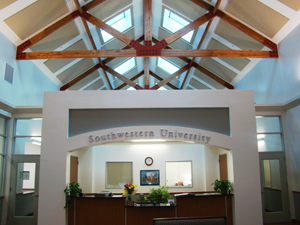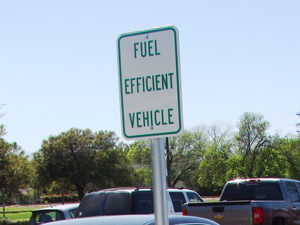Introducing the WCAC:
What is a Postmodern Construction and How Do You Analyze Its Visual Rhetoric?

Introducing the WCAC:
What is a Postmodern Construction and How Do You Analyze Its Visual Rhetoric?

In terms of spaces, modernist architects "believed that they were beyond cultural relativity. They believed that their structure would mirror natural laws, not block them with cultural conventions" (Hattenhauer, 1984, p. 75). Modernists believed that through functional and rational thought, they could transcend culture. Postmodernists, however, problematize modernism as a culture that only thought they were transcendent of culture. Postmodern architecture rejects the notion of a single, universal style of building. It is responsive to its context and audience, and deliberately and explicitly "cites" older architectural styles (Blair, 1991, p. 267). Postmodern structures create "communities of memory" (Dickinson, 1997, p. 5), spaces where culture and identity are created and represented.
I find that these descriptions are especially fitting of the WCAC. The architectural style of the building (e.g. the bricks, doors, and columns) bear many similarities to the much older buildings surrounding it. Built over a century later, however, WCAC's designers are not of the same culture that conceived those older buildings. Rather, the WCAC references and uses that style purposefully.
There are several reasons why it is then appropriate to analyze a postmodern space like the WCAC as rhetorical. The first is that "postmodern architects are quite explicitly interested in their art as a rhetoric, as a partisan and meaningful language" (Blair, 1991, p. 266). If postmodern architects seek to construct spaces as symbolic and rhetorical, it makes sense for us to analyze the rhetorical function of these spaces. The goal of this site, appropriately, is to study the rhetorical function of the WCAC. In a news story on SU's website about the building, they are quite explicit about the WCAC's rhetorical function.
| Oliver said the "green" aspect to the new building should appeal to prospective students, who are very interested in issues such as sustainability and the environment. "It will reinforce that Southwestern is looking to the future and doing what we can to protect the environmental legacy we will hand down to future generations," Oliver said. |
The article quotes Tom Oliver, vice president for enrollment management services at SU. As Oliver states, the goal of the WCAC's "green" initiative is to "reinforce" an image of Southwestern. Similarly, in her book "Exceptional Spaces," Della Pollock (1998) describes "a sense that performance and history are linked together in deep patterns of iteration and reiteration, that performance mobilizes history through and as repetition" (p. 2). The idea presented here is that spaces can do more than represent or symbolize something; spaces can create history through a "spectacular, performative rite" (p. 1). Although my study deals less with history, the underlying idea that spaces can rhetorically perform a version of an event or concept is essential to my analysis. As I stated above, my goal is to analyze WCAC as a space that performs an idea of Southwestern. The stationary Pirate Bike, pamphlets, and free coffee stationed near the entrance all play a part in this performance.
For this study, I'm using visual rhetoric methodologies. Studies of rhetoric have, in general, made a shift toward the visual (Foss, 2004). With this shift, the range of what scholars consider worthy of analysis has greatly expanded. "Rhetorical scholars are analyzing photographs, drawings, paintings, graphs and tables, interior design and architecture, sculpture, Internet images, and film (p. 306).
Also valuable to note here is that Jackson and other scholars (Dickinson & Maugh, 2004; Foss, 2004; Rose, 2007) all bring up the notion that spaces are more than visual. They have sounds, smells, and textures that are enacted on our entire bodies. It is important to address these factors because, as Dickinson and Maugh (2004) state, "A well-rounded understanding of visual rhetoric needs to address the embodiment of visual rhetoric" (p. 260) (emphasis theirs). So while visual rhetorical studies primarily deal with the visual aspects of a space, they also acknowledge that they work on our other senses to create a fully embodied experience.

|

| |
Recontextualizing and Making Meaning
| |
Design, Photography, and Text by Michael Morgan 2009
Email questions or comments to antoniopeter@gmail.com
Works Cited
Progressive Traditions in the WCAC: Home | Introduction | Pirate Bikes | Green Discourse | Progressive Traditions